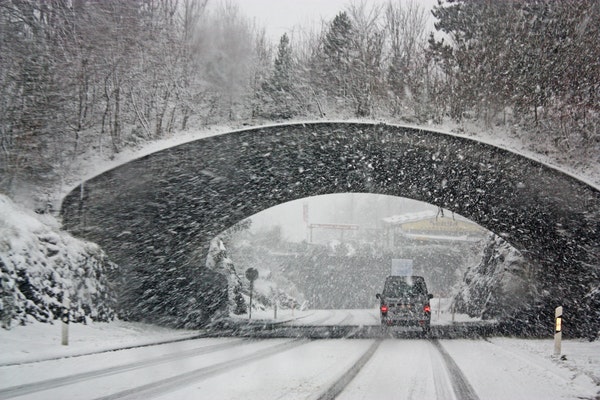Katie Ross, our department manager over here at ACCC, isn’t a regular contributor to Talking Cents Blog. But having recently had to pull to a money-saving move to keep her house warm and her bills down, she wanted to share her advice to readers suffering in the polar vortex/deep freeze. We know that heating your home can be tough when you’re trying to pay off debt. Here’s how to save on emergency oil fees and stay on budget.
Having lived in the cold north all of my adult life, each winter I go through the same thing; I worry about the cost of heating my home. If I don’t schedule oil burner check-ins to make sure I maintain enough heating oil fuel in my tank, I could be up a cold creek. In this post, I am going to tell you about how I handle maintaining my oil furnace and why I don’t set up auto-delivery.
A few years ago, when I moved from a smaller renovated condo with all the amenities one could want (including central air and gas heating), to an older home, I was not surprised to see that the heating system was fueled by oil, which by today’s standards is just not an efficient way to heat your home. But it was what the house came with, so I either needed to live with it or do a complete renovation at $10k… let’s just say I chose to live with it. However, I did have Mass Save come in, and they provided me a home energy audit, which I highly recommend. It’s free and most times you will get free energy products, tips on energy savings, and depending on your situation, they may provide free door seals among other things. In any event, they told me I have a great heating system, considering the age, and it is running at 87% efficiency. They suggested that I invest money into other things such as insulation, which is what I ended up doing. What do you think was more cost-effective: $1000.00 to insulate or $10,000 after I just bought a home? I went with the insulation.
It was a mild winter when I moved that December, and part of my closing deal was a full tank of oil that holds 275 gallons — at today’s oil prices, it came out to $3.78 a gallon or roughly $1041. I was thrilled. But at the same time I was worried — it had been years since I’d dealt with oil heat management and I really didn’t want to sign up for automatic delivery for two reasons. 1) I would take a hit to my credit report (as I already had when I applied for my new mortgage) and 2) I wanted to learn how much fuel I was burning on a monthly basis and in turn, start calculating heating costs into my monthly budget. I knew the potential risks of running out, but I was willing to take the risk.
The phrase “fool me once, shame on you; fool me twice, shame on me” applies here – after running out of oil not once but twice during the first two years, I thought better of letting it happen again. As I was approaching low fuel levels just last week, I remembered a little trick the oil man told me the first time I ran out (wish I’d remembered it before the second time).
Before I tell you what that trick was, let me share with you that the first time I ran out, it was cold showers for the family during almost freezing temperatures, as well as $124 additional dollars in emergency fees. The second time, it was during warmer months and I only incurred a $35 re-priming fee, but either way, I don’t recommend this and neither does my family.
Fast forward to present day, still not on automatic delivery, and ordering my oil from a discount oil company online called “OrderMyOil” with delivery guaranteed in 2-3 business days. What do you think happened? Freezing temps and with the extended forecast teetering at a whopping 5 degrees, I realize I have forgotten to check my oil levels. LOW, LOW, LOW – potential danger (freezing) ahead! I placed my order, but it’s going to take 2-3 days for delivery due to high volume. How am I going to manage not running out completely before they deliver? Should I rush the delivery? Can we make it? As any mom would do, I think of the look on my families if I have to tell them it’s cold showers again, but as a budget-conscious consumer, I remembered that trick the oil man taught me that will give me 24-48 additional heating hours at a fraction of the cost! Happy family faces and no emergency delivery costs, or cost to get the furnace primed again? Sign me up.
Diesel fuel is the answer. You can put diesel fuel in your oil tank; 10 gallons at a time is recommended, and this will keep your home heated for about 24 hours or more, depending on how much oil you burn in a day — my family burns about 4 ½ gallons a day. I went out the first night of my 2-3 day wait and picked up two 2.5 gallons tanks. Warning, not all gas stations carry diesel fuel, so be sure to call the station before you go. With a local station carrying diesel, I now had a total of 5 gallons that I could put in my fuel pipe, which is exactly what I did: 2 x 2.5 gallon tanks = 19.96 and 5 gallons of diesel fuel at $20, with a total cost of $39.96. To me, this was a huge savings, considering I didn’t run out and was able to keep my family warm. I didn’t pay an emergency service fee, which normally runs about $89 to deliver, plus the cost of oil and another $35 to have the burner primed, which you must do to get your heating system operational again.
I had to do this one more day with additional costs of $20 for 5 more gallons, but again, this to me was worth the inconvenience to have not run out and incur emergency delivery fees and tank priming fees.
The company that I continue to get my oil from, OrderMyOil.com, coincidentally just started this week with an automatic delivery option, without pulling credit reports to do so, which I am now in the process of signing up for. We hope these insights can help you save on emergency oil fees.
If you’re struggling to pay off debt, ACCC can help. Schedule a free credit counseling session with us today.







